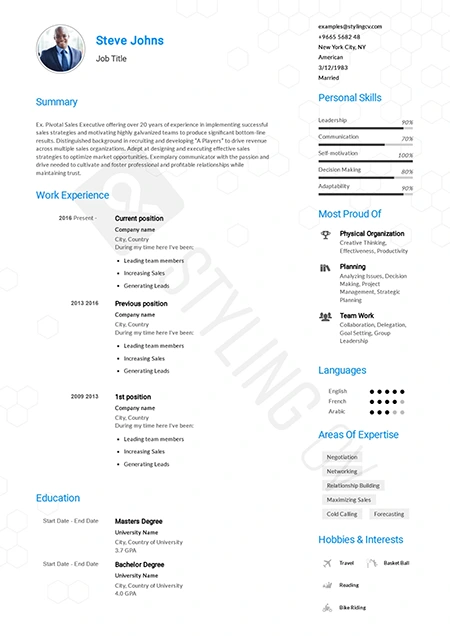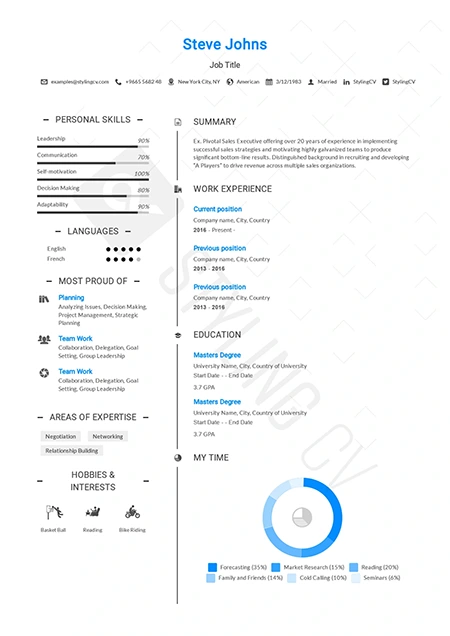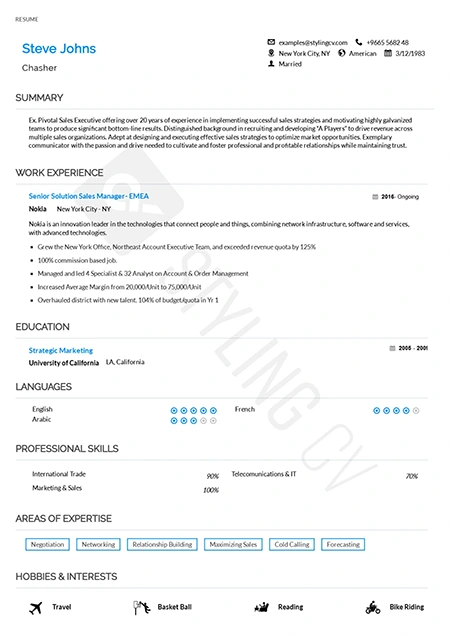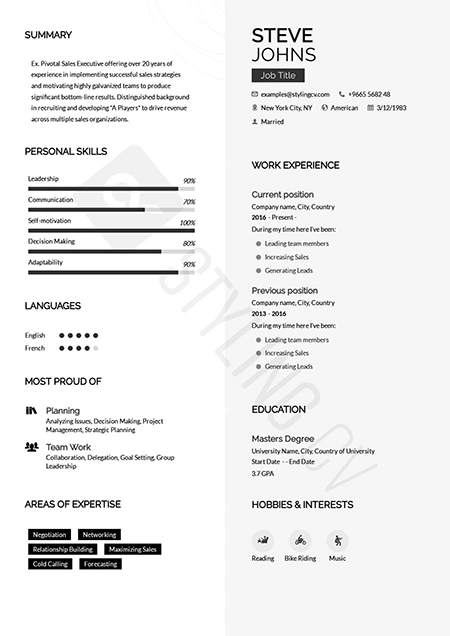wir bieten Ihnen 39+ Lebenslaufvorlagen
39 meistgenutzte professionelle Lebenslaufvorlagen
der einfachste Weg, einen Lebenslauf in verschiedenen Sprachen zu erstellen, ist die Verwendung unserer professionellen Lebenslaufvorlage, die Ihnen hilft, sich auf den Inhalt und nicht nur auf das Design zu konzentrieren.
Ein professioneller Lebenslauf ist immer der erste Schritt, wenn Sie sich für eine Stelle bewerben. Er hebt Ihre Fähigkeiten, Fertigkeiten, eine Zusammenfassung Ihrer bisherigen Erfahrungen, akademischen Qualifikationen und persönlichen und beruflichen Erfolge hervor und gibt Ihnen das Privileg, Ihren Traumjob zu bekommen.
Fangen Sie Ihre Vorlage jetzt!
Beginnen Sie mit unseren 100 Widgets und Farboptionen, um Ihren Lebenslauf zu erstellen.
 Wählen Sie
Wählen Sie Ein minimalistisches Design für Lehrer und Erzieher. Klare Informationsgrafiken, die Ihre Fähigkeiten in Ihrem Lebenslauf deutlich herausstellen.
 Wählen Sie
Wählen Sie Ein einfacher Lebenslauf, der sowohl die Fähigkeiten als auch die Fertigkeiten in einem einfachen und lesbaren Format darstellt
 Wählen Sie
Wählen Sie Die spitze Kopfzeile mit ihren kräftigen Farben ist ein dominanter Auftritt für Ihren Lebenslauf. Ihre Fähigkeiten haben einen großen Platz auf der linken Seite in diesem Lebenslauf Vorlage.
 Wählen Sie
Wählen Sie Gelernte Sprachen, fachliche und soziale Kompetenzen sowie Hobbys finden auf der linken Seite ihren Platz. Während Ihre schulischen und beruflichen Fähigkeiten in dieser Lebenslaufvorlage auf der rechten Seite stehen
 Wählen Sie
Wählen Sie Eine helle und bunte Lebenslaufvorlage. Werden Sie von den Personalverantwortlichen sofort mit einer vielfältigen Liste von Farben gesehen
catics-de

Testen Sie StylingCV jetzt KOSTENLOS.
Es ist ganz einfach!
Meinen Lebenslauf JETZT erstellen
Was ist ein Lebenslauf?
Ein Lebenslauf ist eine kurze Zusammenfassung Ihrer beruflichen und persönlichen Erfahrungen, Fähigkeiten und Ihrer akademischen Ausbildung.
ein gut geschriebener Lebenslauf mit einem Anschreiben kann den Unterschied zwischen einem Vorstellungsgespräch und der Ablehnung einer Stelle ausmachen. Lesen Sie mehr darüber, wie man einen Lebenslauf schreibt.

Wie schreibe ich einen Lebenslauf für Ihren ersten Job?
Das Schreiben eines Lebenslaufs kann Ihnen sehr einschüchternd erscheinen. Schließlich beziehen sich die meisten Lebenslaufbeispiele, die Sie auf Websites sehen, zu 80 % auf Berufserfahrung. Was kann also in Ihren Lebenslauf aufgenommen werden, wenn Sie keine Berufserfahrung haben?
Nun, hier ist eine gute Nachricht. Wenn Sie sich für Ihre erste Stelle bewerben, erwartet niemand von Ihnen, dass Sie bereits über Berufserfahrung verfügen.
Stattdessen sollten Sie sich auf das konzentrieren, was Sie haben:
- Bildung
- Projekte
- Ehrenamtliche Erfahrung
- Hobbys und Interessen.
Über den vollständigen Leitfaden Wie man einen Lebenslauf ohne Berufserfahrung erstellt

Was schreiben Sie in einen Lebenslauf?
während des intensiven Wettbewerbs auf dem Markt, mit großen und grundlegenden Veränderungen, wurde das Schreiben eines professionellen Lebenslaufs zu einem Schlüsselfaktor für Ihren Erfolg, um den Job Ihrer Träume zu bekommen
Hier finden Sie einige wichtige Punkte, die Sie in Ihrem Lebenslauf berücksichtigen sollten:
- Kontaktinformationen
- Zusammenfassung von Lebenslauf und Ziel
- Frühere Erfahrungen
- Akademische Ausbildung
Wenn Sie Ihren Lebenslauf personalisieren möchten, können Sie auch die folgenden Abschnitte einfügen:
- Projekte
- Ehrenamtliche Erfahrung
- Hobbys und Interessen
Weitere Informationen darüber, wie Sie diese Abschnitte in einem Lebenslauf unterbringen, finden Sie in unserem Artikel Was in einen Lebenslauf gehört.

Wie koordiniert man das Format eines Lebenslaufs?
Es gibt 3 typische Lebenslaufformate:
- Umgekehrtes Zeitformat
- Format für die Koordinierung von Arbeitsplätzen auf der Grundlage von Fertigkeiten
- Die umfassende Koordinierung kombiniert die beiden vorherigen Formate
In 99 % der Fälle werden Sie das Format mit umgekehrter Zeitangabe verwenden. Der Lebenslauf konzentriert sich hauptsächlich auf Ihre Arbeitserfahrungen und wird in umgekehrter zeitlicher Reihenfolge geschrieben (d.h. die Erfahrungen werden von der neuesten zur ältesten geordnet).
Wenn Sie keinen Lebenslauf mit einem fähigkeitsbasierten Jobformat erstellen möchten, empfehlen wir Ihnen, bei dem umgekehrten Zeitformat zu bleiben.
Wenn Sie mehr über Lebenslaufformate erfahren möchten, lesen Sie unseren Vergleichsleitfaden.
Passen Sie Ihren Lebenslauf immer an die gewünschte Stelle an
Wollen Sie 50 Lebensläufe verschicken, um nur zwei Vorstellungsgespräche zu bekommen? ODER wollen Sie acht Lebensläufe verschicken und drei oder vier Vorstellungsgespräche bekommen?
Wenn Sie die zweite Option wählen, ist es ganz einfach. Achten Sie darauf, Ihren Lebenslauf so zu schreiben, dass er zur Berufsbezeichnung der Stelle passt, auf die Sie sich bewerben möchten.

Wie lang sollte ein Lebenslauf sein?
Wie viele Seiten sollte ein Lebenslauf haben?
Die häufigste Lebenslauffrage der Welt: "Wie lang sollte Ihr Lebenslauf sein?"
Antwort: eine Seite. Wenn Sie über viel Berufserfahrung verfügen (10 Jahre und mehr), ist es manchmal sinnvoll, maximal zwei Seiten daraus zu machen, wenn alles, was Sie erwähnt haben, für die Stelle, auf die Sie sich bewerben, relevant ist.
Hinweis: Alle unsere Vorlagen sind einseitige Lebensläufe. Wenn Sie weitere Erfahrungen hinzufügen, wird automatisch eine zweite Seite eingefügt, so dass Sie keine Probleme haben werden, das einseitige Limit einzuhalten!

Wie schreibt man eine Zusammenfassung des Lebenslaufs?
ziehen Sie die Leser an, indem Sie eine Zusammenfassung am Anfang des Lebenslaufs hinzufügen. Betrachten Sie sie als Einleitung zu Ihrem Lebenslauf. Sie sollten in zwei bis vier Sätzen Ihre Fähigkeiten, Erfahrungen und Ihre Eignung für die Stelle, auf die Sie sich bewerben, hervorheben.
lassen Sie Ihr persönliches Resümee glänzen, indem Sie diese perfekte Formel verwenden:
[Berufsbezeichnung] mit X + Jahren Berufserfahrung in [Berufsverantwortung]. In X von Jahren habe ich [die wichtigsten zwei oder drei] Leistungen erbracht. Ich finde, dass ich für [Titel] in [Name des Unternehmens] gut geeignet bin.
Wenn Sie mehr darüber erfahren möchten, wie Sie eine professionelle Zusammenfassung Ihres Lebenslaufs erstellen, lesen Sie unseren Leitfaden.
Wenn Sie hingegen Student sind oder noch nicht viel Berufserfahrung haben, lesen Sie mehr darüber, wie man einen Lebenslauf für Studenten erstellt.

Wie man Arbeitserfahrungen in einen Lebenslauf schreibt
Wie man Arbeitserfahrungen in einen Lebenslauf schreibt
Praktische Erfahrungen im Lebenslauf Eines der Dinge, die leicht zu lernen und schwer zu meistern sind
- Berufsbezeichnung
- Der Name des Unternehmens / der Institution / des Arbeitgebers
- Errungenschaften oder Verantwortlichkeiten
- Datum der Arbeit
Wenn Sie einen herausragenden Erfahrungsbericht schreiben wollen, sollten Sie sich auf messbare Leistungen konzentrieren.
Verwenden Sie diese Formel: Ich habe das Problem (x) gelöst, indem ich (y) getan habe, um das Ergebnis (z) zu erhalten.
Beispiel: Verhandeln Sie einen Plan mit den Lieferanten, um die Bürokosten um $ 5.000 jährlich zu senken.
Zeigen Sie Ihre Leistungen anhand von Zahlen. Geben Sie keine sensiblen Informationen an.
hat seinen Umsatz in 12 Monaten um 20% gesteigert.
Das zeigt dem Arbeitgeber, dass Sie nicht nur ein beliebiger Kandidat sind, sondern ein ausgezeichneter Mensch!
Wenn Sie mehr darüber erfahren möchten, wie Sie Leistungen in Ihrer Berufserfahrung schreiben (und den Job bekommen), lesen Sie unseren Artikel.

Wie führt man Kompetenzen in einem Lebenslauf auf ?
Erstellen Sie einfach einen Abschnitt "Fähigkeiten" in Ihrer Lebenslaufvorlage und listen Sie Ihre wichtigsten Fähigkeiten auf.
Wir empfehlen in der Regel, technische und persönliche Fähigkeiten zu schreiben.
Sie wissen nicht, welche Fähigkeiten Sie in Ihren Lebenslauf aufnehmen sollen? Sehen Sie sich die 50 besten Fähigkeiten an, die Ihren Lebenslauf bereichern.

Wie erstellen Sie ein Anschreiben für Ihren Lebenslauf?
Zu jeder Bewerbung gehört ein Anschreiben (zusätzlich zu Ihrem Lebenslauf). Hier sind einige Tipps, wie Sie es richtig machen:
- Richten Sie Ihr Anschreiben persönlich an den Arbeitgeber. Je persönlicher Sie sind, desto wahrscheinlicher ist es, dass Ihre Erfahrungen Anklang finden.
- Nennen Sie Ihre allgemeinen Erfahrungen (Berufserfahrung, Berufsbezeichnung usw.) und führen Sie die 2 bis 3 wichtigsten Leistungen auf, die Ihre Fähigkeiten belegen.
Wenn Sie wirklich herausstechen wollen, erstellen Sie ein Anschreiben, das zu Ihrer Lebenslaufvorlage passt. Dazu können Sie eines unserer Anschreiben verwenden.

Was ist die beste Lebenslaufvorlage?
Eine "beste Lebenslaufvorlage" gibt es nicht - jeder Arbeitnehmer/Arbeitgeber hat seine eigenen Merkmale. Wir empfehlen, dass Sie sich über das Unternehmen, bei dem Sie sich bewerben, informieren.
Wenn Sie sich zum Beispiel für eine Stelle bei einer Bank bewerben, sollten Sie eine professionellere Lebenslaufvorlage verwenden. Wenn Sie hingegen eine Stelle in einem Startup-Unternehmen anstreben, in dem Innovation großgeschrieben wird, sollten Sie sich an diese kreative Lebenslaufvorlage halten.
Wenn Sie sich schließlich immer noch nicht sicher sind, welche Art von Vorlage für die Stelle, auf die Sie sich bewerben, die richtige ist, können Sie eine der professionellen Lebenslaufvorlagen verwenden, die zu dieser Stelle passt.
Lebenslauf Ressourcen
Was ist ein Lebenslauf?
Ein Lebenslauf ist eine kurze Zusammenfassung Ihrer persönlichen und beruflichen Erfahrungen, Fähigkeiten und Ihrer Ausbildung. Sein Hauptzweck besteht nicht nur darin, sich von Ihrer besten Seite zu zeigen, sondern auch darin, Sie zu beschäftigen, indem Sie zeigen, was Sie von anderen Bewerbern unterscheidet, die sich möglicherweise um dieselbe Stelle bewerben!
Sie wissen, wie man einen Lebenslauf erstellt, aber wenden Sie auch die richtigen Strategien an? Wir haben alle schon von "guten" und schlechten Lebensläufen gehört. Aber was ist mit den großartigen Lebensläufen - der beste Weg für Arbeitssuchende, die ihre Erfolgschancen bei der Arbeitssuche um das Doppelte oder mehr erhöhen wollen! Lesen Sie diesen Leitfaden zur Erstellung eines hervorragenden Lebenslaufs, der den Personalverantwortlichen bei der Prüfung ihrer Bewerbungen wirklich etwas bietet, das sie abhaken können.
Wie schreibe ich einen Lebenslauf für meinen ersten Job?
Das Schreiben eines Lebenslaufs mag Ihnen unheimlich erscheinen. Schließlich bestehen die meisten Lebensläufe zu 80 % aus Berufserfahrung und zu 20 % aus einer Zusammenfassung anderer Leistungen, was es für diejenigen, die keinerlei berufliche Erfolge oder Ausbildung in diesem Bereich haben, schwierig machen kann!
Ich weiß, dass es nicht einfach ist, vor allem, wenn so viel Wert darauf gelegt wird, so schnell wie möglich einen Fuß in die Tür zu bekommen, aber keine Sorge - wir haben einige Ideen, wie Sie sich von anderen abheben können...
Viele Leute haben gesagt, auch ich, als ich gerade in der Branche anfing und mich selbst für Jobs oder Praktika beworben habe, dass niemand erwartet, dass Sie irgendeine Berufserfahrung haben. Die Idee ist, dass ein Arbeitgeber Stellen allein aufgrund von Ehrgeiz vergibt, also hilft es wirklich, sich vorher zu informieren!
Wenn Sie eine berufliche Veränderung anstreben und keine Berufserfahrung haben, sollten Sie dafür sorgen, dass Ihr Lebenslauf auffällt. Lesen Sie unseren Leitfaden zum Verfassen eines Lebenslaufs ohne Berufserfahrung.
Was soll in einen Lebenslauf?
- Sektion Kontakt
- Lebenslauf Zielsetzung oder Zusammenfassung
- Berufserfahrung
- Akademische Qualifikationen
- Fertigkeiten
- Auszeichnungen & Errungenschaften
- Sprachen
- Ehrenamtliche Arbeit
- Hobbys
- Außerschulische Aktivitäten & Projekte
Weitere Informationen darüber, wie Sie diese Abschnitte in Ihrem Lebenslauf platzieren können, finden Sie in unserem Artikel. 10 wichtige Abschnitte im Lebenslauf im Jahr 2025
Wie formatiert man einen Lebenslauf?
Unter den effektivsten Lebenslaufformaten für das Jahr 2025 haben wir für Sie die besten ausgewählt und aufgelistet, aus denen Sie das beste Lebenslaufformat für Ihre jeweiligen Anforderungen und Ihren Jobbedarf auswählen können:
- Umgekehrte Chronologie oder Karriereleiter Lebensläufe
- Auf Fähigkeiten und Kompetenzen basierende Lebensläufe
- Funktionale Lebensläufe
- Allrounder Lebensläufe
- Hybride oder kombinierte Lebensläufe
Der umgekehrte chronologische Lebenslauf ist der häufigste Typ im beruflichen Umfeld. Er betont Ihre Berufserfahrung und ist in umgekehrter chronologischer Reihenfolge verfasst, z. B. mit Datumsbereichen, die den Aufstieg in einem Unternehmen oder eine Stellenbezeichnung im Laufe der Zeit zeigen.
Wenn Sie mehr über Lebenslaufformate erfahren möchten, lesen Sie unseren Artikel Beste Lebenslaufformate für 2025.
Wie lang sollte ein Lebenslauf sein?
Kurze Antwort: eine Seite.
Wie schreibt man eine Zusammenfassung des Lebenslaufs?
Eine Zusammenfassung des Lebenslaufs ist eine kurze Beschreibung Ihrer Erfahrungen, Fähigkeiten und Qualifikationen. Sie spricht den Personalverantwortlichen an und sagt ihm, warum er Sie einstellen sollte. Wenn Ihre professionelle Zusammenfassung klar und prägnant ist und den Anforderungen des Personalchefs entspricht, wecken Sie sein Interesse und ermutigen ihn, Ihren Lebenslauf weiter zu lesen.
Wenn Sie mehr darüber erfahren möchten, wie Sie eine Zusammenfassung Ihres Lebenslaufs erstellen, lesen Sie unseren Leitfaden 40 Beispiele für Zusammenfassungen im Lebenslauf (How-to Guide)
Berufserfahrung im Lebenslauf auflisten
Ihre Berufserfahrung bietet Ihnen die Möglichkeit, Ihre Leistungen, Verantwortlichkeiten und Aufgaben aufzulisten. Sie können Ihre Berufserfahrung wie folgt auflisten:
- Berufsbezeichnung: Geben Sie bei jedem Jobeintrag als ersten Teil Ihre Berufsbezeichnung an.
- Name des Unternehmens: Geben Sie den Namen des Unternehmens und den Ort an, an dem Sie in einer bestimmten Funktion gearbeitet haben.
- Errungenschaften/Verantwortung: Führen Sie entweder Ihre Leistungen oder Ihre Verantwortlichkeiten in der Rolle auf. Seien Sie so detailliert wie möglich. Zum Beispiel: "Ich habe eine neue Schlüsselwort- und Titelvorlage für organisches Inbound-Marketing erstellt und das Blog-Engagement innerhalb von 3 Monaten um 20% gesteigert".
- Beschäftigungsdaten.
Wie führt man Fähigkeiten in einem Lebenslauf auf?
Laut der jüngsten Umfrage einer Karriere-Website neigen Menschen oft dazu, bizarre Fähigkeiten in ihren Lebenslauf zu schreiben, die für die angestrebte Stelle oder den angestrebten Berufszweig keine besondere Bedeutung haben. Das führt dazu, dass der Arbeitgeber den Lebenslauf entweder auf den Ablagestapel wirft oder ihn nach einem flüchtigen Blick wegwirft. Daher scheint es eine schwierige Aufgabe zu sein, die besten beruflichen Fähigkeiten herauszufinden, die zu jeder Art von Berufswahl passen. Um die Sache einfacher und effektiver zu machen, haben wir eine Liste mit 101 essentiellen Fähigkeiten zusammengestellt , die Sie in Ihren Lebenslauf aufnehmen sollten [für jeden Job]. Diese beruflichen Fähigkeiten können Sie in Ihren Lebenslauf für jede Stelle einbauen, auf die Sie sich bewerben.
Wie verfasst man ein Anschreiben für einen Lebenslauf?
Die Jobsuche nervt. Das Durchsuchen von Online-Stellenangeboten, das Verfeinern Ihres Lebenslaufs und die Vorbereitung auf zermürbende Vorstellungsgespräche - nichts davon macht Spaß. Für viele ist der entmutigendste Teil des Prozesses das Verfassen eines Anschreibens. Es gibt so viele widersprüchliche Ratschläge, dass es schwierig ist zu wissen, wo man anfangen soll.
Wenn Sie mehr darüber erfahren möchten, wie Sie ein effektives Anschreiben verfassen, lesen Sie unseren umfassenden Leitfaden.
































